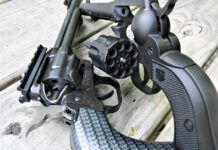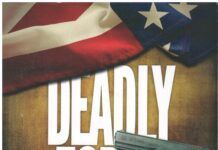There are plenty of guns in the $1,000 to $3,000 range. When most shooters who have become serious about the sport look to upgrade to something fancier, they usually end up searching in the $10,000-and-up range. Why? Because there just arent a lot of offerings in the midrange price class.
However, we found two 12-gauge sporting-clays guns in that midrange price zone-the Blaser F3 Competition Sporting, $5,195; and Berettas 687 EL Gold Pigeon II Sporting No. J687526, $5,495. Though both were worth the bucks, we favor the Blaser, for reasons we detail below.
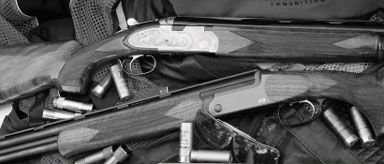
We shot several hundred rounds through the guns on several different sporting clays courses offering a variety of difficulty levels. The subtle differences we found in handling and balance are factors that experienced competitive shooters will appreciate (its hard to imagine a beginner competitor would start with one of these, so this line-up isnt aimed at them), especially those looking to get out of the Browning 525-class of guns without dumping $10K or more into a Kreighoff or Perazzi.
For accuracy, we shot the guns standing at 40 yards as measured by a Bushnell rangefinder (as if for patterning) and from the Shooters Ridge Steady Rest on Midway USAs MTM portable shooting bench for point-of-impact tests, using the National Target Companys shotgun patterning target (both proved accurately regulated). Trigger pulls were measured by an RCBS trigger-pull gauge provided by Midway USA. Heres what we found:

Beretta 687 EL Gold Pigeon II
Sporting, J687526, $5,495
Open the hard case that comes with this gun, and its hard not to gasp “oooohhh!” This is one pretty gun, especially if youre into heavy engraving. Thats what wed expect for upgrading out of the first-buyers price range-good looks, that is. We want to see improved fit and finish, more embellishments, and a better piece of wood. The Beretta 687 EL Gold Pigeon II Sporting has all of that.
The receiver, which is the most eye-catching portion of the gun, has false sideplates engraved in the high profile bas-relief style. On the left appear three flushing pheasants against a backdrop of rolling, rising hills, an oak tree, and grasses, the latter swirled into ambiguity at the front and back end of the scene. The only thing out of place is a small gathering of conifers in the scenes left corner-well, at least out of place when it comes to any pheasants weve ever hunted. On the right side is a trio of quail on the flush in front of what could be either be a short-tailed English pointer or a too-long-tailed German shorthair. Whichever it is, the dog is depicted in an old-fashioned manner, tail down. Again, there are the hills in the backdrop and bits of tree, log, and grass swirling around the quartet (but no pine trees).
The bottom of the receiver, fences, top tang, and toplever joint are engraved in a scroll-type manner, with flowers embedded at screw and pin points, as well as at the toplever head. The model name and number appear at the receiver underside, lightly integrated with the scroll. The trigger guard has a double-leaf pattern surrounding the Beretta trident symbol.
Though we could pick apart the engraving for legitimacy-pine trees with the pheasants, the ambiguous breed of pointing dog-we really had only one true objection, and that was the forescrew attaching the trigger guard tang to the receivers underside. It was intended to bear the same flower motif as the other screw points, all of which are well executed. But this one not only has an oversized slot in it, which disrupts the pattern, it has a second small, gold inset screw near the top that interrupts both the pattern and the overall motif-no other gold appears anywhere but the trigger. Worst of all, its not aligned with the slot its set into, rather criminal compared to the care taken with the others.
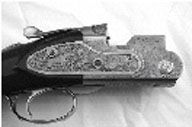
The wood on both the buttstock and Schnabel forend are a good match to the heavy engraving on this gun, possessing strong figuring in shades of dark to milk chocolate. The checkering, however, left something to be desired. Though a tight pattern of 24 lines per inch, the relief is so low as to offer almost no more purchase than the rest of the wood. It looks nice, but on hot days will be slick in an ungloved hand. The border is also a bit roughly done and has some runover at the points.
That runover was indicative of the rest of the fit and finish between wood and metal on the gun. We noticed a few places along the butt pad where the wood just wasnt as flush as it should be-a couple more passes with the sandpaper before the gloss finish was added would have easily solved this. Too, at the underside of the receiver, theres at least one point on the exposed wood edge of the inletting thats not stained. And on the metal itself, the toplever has a half-dozen lateral cuts across just its top edge, assumedly to aid thumb purchase, yet because theres so little of it and its not cut deeply, to us it looks cheaply done. Beretta so well executed the opposing hatch marks on the safety/barrel selector, we wondered why they couldnt be bothered doing the same on the toplever. Finally, the back edge of the butt pad, where it has been ground down to round what might have been an edge (it doesnt actually look like there was much of one), is unevenly and roughly done.
These are tiny points, but we think these finish discrepancies are an issue for a gun in this price range. In our opinion, potential buyers should examine several samples of this model for fit and finish details at these points (and anywhere else for that matter) before committing their wallets.
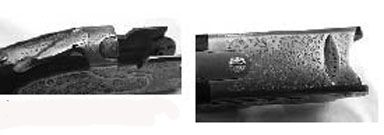
Overall, this is a beautiful gun. It also shot as well as wed hoped.
Equipped with 32-inch barrels, this gun was one of the most controllable weve shot in a long time. Even a mismount (which happened frequently during testing, thanks to this guns long 14.75-inch length of pull, 0.75 inches longer than our main test shooter was used to handling) didnt prevent us from realigning everything to make the break. The balance is forward, but the barrels themselves are anything but clubs, making corrections a real possibility, a big bonus in a competitive gun.
Function was flawless. Even the lightest loads we shot, Winchesters X-tra Lights, never failed to reset the firing pin for the second barrel (ditto for the F3). Likewise, the barrel selector and safety. This gun does not auto-safe, as to be expected with a competitive over/under, and it took positive pushes on the selector/safety to engage either function, which means no accidental bumping.
Elsewhere, the trigger was crisp, with almost no takeup, and creep was nonexistent. We also like that the traditionally styled forend latch stayed open upon prying, with the forend itself easily disengaging and reengaging.
The EL Gold Pigeon II was straight as an arrow on the shoulder on our right-handed test shooter, thanks to a bit of cast-off. Yet the cast-off is subtle enough that we dont think most lefties will feel canted; the super-sensitive will want to have the stock bent the other way by a qualified stockman, or talk to Beretta about the possibility of have the stock ordered cast-on. The vent rib (the barrels are separated from the forend lug back, but not forward to the muzzle) is fairly low profile, which also helped with the excellent view to the white end bead. The barrels are not ported, but we didnt feel the gun needed it; muzzle rise wasnt an issue.
The only other things we wish Beretta had included were extended choke tubes. No one on a sporting-clays course uses flush-mount tubes any more, so at this price, and because of the specifically competitive designation of this gun, a set of extended tubes is the right move.
Other than the cosmetics noted above, the only drawback we could really find was that its weight was too far forward for several averaged-sized test shooters. The weight distribution didnt affect control to the target, but it did affect how the shooter felt over a long course. Several commented how much effort they were putting into mounting the gun near the end of a 100-round course, feeling the strain across their shoulders, back, and even biceps. Thirty-inch barrels might have countermanded this some, but we still have to conclude that as much as we love this guns handling characteristics, this is a big boys gun. It needs someone with the build and muscle to keep pushing it around, especially given the circumstances of most sporting clays shoots: hot weather, 100-round-plus main events, plus numerous side-game and warm-up rounds add up to a lot of gun lifting over a day or weekend. This gun is not for the weak of stature.
Blaser/Sigarms F3, $5195
Compared to the Beretta, the Blaser/Sigarms F3 is less embellished, so if thats what youre seeking in a competition upgrade, then youll be disappointed. However, this gun is not a plain Jane.
Our sample possesses a very nice piece of wood, well striped laterally, with quite a bit of shimmery tiger striping as you turn the gun to catch the light. Checkering at the wrist and forend isnt nearly as tight at 17 lines per inch, but it is well done. Its also done in a very non-traditional way, with the bumps between the lines rounded, rather than left sharp. It provides good purchase for the hand, we thought.
The buttstock possesses a palm swell large enough to be felt without being obtrusive. The Berettas proved smaller. Theres just the tiniest bit of cast-off with the F3, so this will be an excellent choice for shooters of either hand; the right-side palm swell shouldnt disturb a leftie, though they miss it if they had had a left-handed gun before. A truly left-handed gun can be ordered at extra charge.
The forend is Schnable, but it keeps with the angular lines of the gun by possessing no belly and flaring at the end without dramatics. As for the receiver, the flat, gun-metal-gray finish is virtually unadorned. A gold “F3” model designation is inlaid at the lower rear of each side of the receiver, and “Blaser,” in darker gray, is inset on the underside. Thats it. If you can call contrasting shades of black and grey, such as those between the receiver and the hinge-pin cover, trigger guard, top tang, and toplever, then you have a wider definition of embellishment than us. Overall, the gun is striking in a distinctly stark, German, sharp-angled way. It doesnt make you want to touch it like the Beretta does, but it doesnt lack its own beauty.
Handling is what really earned this gun the “wow” factor. The F3 is nearly surgical in its precision. It absolutely goes where your hands go-no pushing, no shoving, no grasping for control. We even managed to make the break with more than a few bad mismounts (the F3 is a bit long out of the box at 14.6 inches length of pull, similar to the Beretta). The only thing we found a bit weird about this gun, functionally speaking, was its barrel selector. The safety is top-tang mounted like normal, but the barrel selector is in a forward/backward-activated switch located within the trigger guard in front of the trigger. No, no one will hit it accidentally, but it is odd to find it there.
A bit more on the F3s handling: Not only did it fare well for our test shooters on the clays courses, but one of our shooters took it to Alaska for duck and ptarmigan hunting. Even in a crowded, made-on-the-spot blind on a bay shore, the F3, with its 32-inch tubes and 3-inch chambers, performed marvelously, taking several cackling geese and a limit of brant. Plenty of ptarmigan fell to the gun, too, back on the tundra. That shooter didnt even really notice much more recoil from the 3-inch BB shells used on the sea fowl, and that says a lot about how an over/under is constructed and balanced.
Part of guns excellent handling abilities have to do with the barrel construction. On an F3, the 32-inch barrels weigh the same as the 30-inch barrels, which weigh the same as the 27-inchers and any other barrel length offered. Blaser incorporated that feature so that should a person wish to use the gun, say, for grouse hunting, where they might want to switch to a shorter 27-inch barrel, he or she would feel no difference in the guns swing or momentum. We believe that even though our test version weighed in at 8.5 pounds, a full half-pound heavier than the Beretta, the lightened barrels were the reason our test shooters didnt feel worn out shooting this one. The competition version (there are field configurations, as well) is also equipped with Blaser/Sigs “Balancer,” a threaded, two-piece weight set in the stock that shooters can adjust individually to accommodate their preferred point of balance. Use one, use both, use neither, spread them apart, put them close to the receiver or close to the butt pad, whatever, its totally up to the shooter (a stock wrench is included with the gun for easy access without a gunsmith).
Blaser/Sig goes yet another step in buyer adaptation. If you have a pretty good idea what your desired stock dimensions are (LOP, drop at comb, drop at heel, etc.), the company offers two sets of stock dimensions on the F3, out of the box, one of which will undoubtedly be closer to yours. One doesnt cost more than the other, and even if neither is exact, the closer you can get off the shelf, the less work your stocksmith has to do. You can custom order an F3 to your exacting dimensions (which will cost extra), but to have two sets of stock dimensions available to buyers with no cost difference is revolutionary in terms of consumer accommodation. We think these factors, mated with the guns superb handling skills and evenly weighted barrel selection, justify its price tag.
Gun Tests Reccommends
Beretta EL Gold Pigeon II Competition Sporting $5,495. Conditional Buy.
If youve yearned for a Kreighoff but cant bring yourself to shell out the bucks, then the EL Gold Pigeon II may be a perfect choice at roughly half the price. Its certainly no less functional or beautiful, in our opinion. We loved the way this gun shoots and its pretty, pretty looks, despite some nitpicking with the fit and finish and the lack of extended choke tubes. Theres a lot of value here for the money.
Still, we give this gun a Conditional Buy, not because it has forward balance-nearly all sporting-clays guns have forward weight, thats a necessity in the clays game-but because of how much it has. The particular way the Beretta balances will probably narrow the pool of shooters who want that aspect. Try before you buy, if possible.
*****
Blaser/SigArms F3, $5195. Best Buy.
Can a gun that costs so much still be a Best Buy? Compared to guns that cost twice as much, we think so. Clean good looks, outstanding handling, extended choke tubes, integral fiber-optic sights, dual stock configurations to choose from, the Balancer weight distribution system, and an array of equally weighted barrels make the F3 a complete package thats worth a steep price tag. The only ones who wont like it are those looking for the fancier look of the Beretta, but they should shoot this one before they decline to open their wallets. After all, this is about putting “Xs” on the score sheet, not whose gun looks best doing it. GT
Written and photographed by C. Fergus Covey, using evalua-tions from gUn.tests team testers.

























